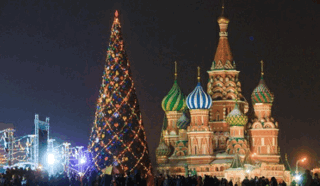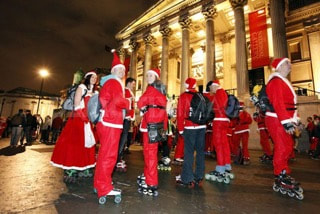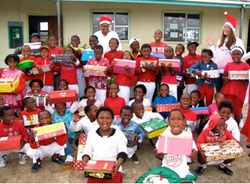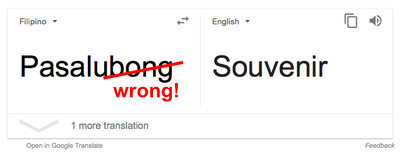Looking out this little window at the solemn, cold night sky, I’m thinking about all of the countries and the people I’m flying over, and what they do to celebrate Christmas. (Actually, I’m thinking about why I was too cheap to pay for an exit row seat and when the flight attendant is coming back with the drink cart, but the first version sounds better.)
So I decided to research and jot down some fascinating Christmas traditions from around the world, reminding us that through our many differences, we are all really the same.
Merry Christmas and happy holidays!
(Ohhh…here comes the drink cart!)

Although the Philippines is a country in Southeast Asia, its residents are about 90% Christian and 80% Roman Catholic due to Spanish colonization, so Christmas is a BIG deal. In fact, they celebrate the longest Christmas holiday in the world, spanning from September until well after New Years.
Aside from ubiquitous light shows, malls filled to the brim, and decorated trees, there are many great Christmas traditions in the Philippines.
Many Filipinos practice the tradition of Simbang Gabi, where they attend church service at 4 am for the nine days leading up to Christmas Eve.
On Noche Buena - Christmas Eve - the whole extended family gets together for a feast of lechon, or a roasted pig.
Singing is always popular in the Philippines, but even more so around Christmas, when children go door to door singing carols.
There’s even a Giant Lantern Festival (Ligligan Parul Sampernandu) in the country, held the Saturday before Christmas in the city of San Fernando – the “Christmas Capital of the Philippines.” Local residents, visiting Filipinos, and even foreign travelers gather to witness hundreds of paper lanterns lit and send aloft by candles, or even electric-colored bulbs these days.
But I have my own new Christmas tradition in the Philippines, as I dress up like Santa Claus and visit sick kids with cancer as well as give out food to street kids. It’s damn hot in that suit!

The Christians in China, who celebrate Christmas, decorate their homes with ornate paper lanterns, all lit up for the big day. The Chinese version of Santa Claus is called Dun Che Lao Ren.
Turkey
Turkey is now a predominantly Muslim nation, although moderate, and their winter holiday revolves more around New Year's Eve, called The Great Day. But they also hold the distinction of being the historical home of real-life Santa Claus, or Noel Baba in Turkish, a monk named Saint Nicholas that lived in 280 A.D. Some Turkish people and visiting foreigners still visit Saint Nicholas’ ancient home for the Christmas season.
France
In France, Santa is known as Pere Noel and is always attended by Pre Fouettard, who keeps the list of who has been good and bad for him. Pere Noel comes to deliver small gifts to the children on December 6 and then returns with more on Christmas day, but the adults wait until New Years Day to open theirs.

Christmas is a huge celebration in this part of Africa, with preparations and festivals for many weeks beforehand. Everyone tries to get home by December 24 to visit their ancestral birthplace. Huge feasts of goat, mangoes, cashew fruits and chicken stew are prepared, and a mango, guava, or cashew tree in the center of the courtyard is decorated with lights and paper ornaments.
Italy
The exchange and opening of presents doesn't happen until the 6th of January, the day believed to be when the Wise Men reached the baby Jesus. Instead of Santa, the Italians have La Befana, a women who gives gifts to those who have been good and punishes bad children, based on the woman who refused to help the Wise Men with food and shelter.
India
In India, they decorate their houses with lights on windowsills, a star hung outside, and strings of mango leaves. The tradition is to make thali, a sweet holiday dessert, and give it to friends and neighbors.
Denmark
Santa Claus is called Julemanden, and his elves are Juul Nisse, but they live in the attic of their homes, not the North Pole. Children leave out rice pudding and saucers of milk for them, not cookies.

The Japanese are not a Christian nation, but celebrate a form of Christmas with the giving of gifts from a Santa Claus-like figure called Hoteiosha. But an even more colorful Christmas tradition is their affinity for feasting on Kentucky Fried Chicken for the holiday, with special menus, lines around the block, and a Japanese Colonel Sanders wearing a Santa Claus outfit!
Mexico
Mexicans call Christmas, Navidad, celebrated for nine days with Las Pasadas. They follow a tradition of dressing like Mary and Joseph and going door-to-door reenacting events of the Bible, when there was no room, and then celebrating with food, song, and a Pinata for the children. Finally, on the ninth night, they are told yes, there is room for Mary in the stable, and everyone heads to church to celebrate.
Belgium
The children here believe in a Saint Nicholas who delivers their presents, but this one rides a horse. So it’s a tradition to leave hay, carrots, and water outside the house on December 6 for Saint Nic’s horse.

The Russians used to celebrate Christmas with great glee before the revolution of 1917, carrying sticks with stars on them through the streets, representing the Stars of Bethlehem. After it became the Soviet Union, religion was banned so the traditions went dormant for many decades. But now, they've been reintroduced with slight differences – Saint Nicholas is now known as Grandfather Frost and wears blue, not red, and they decorate a tree and celebrate on New Years Day.
Sweden
Santa Claus is actually called Tomte, who is a gnome that emerges from under the floor of the house or barn, carrying a sack of presents for the kids. Tomte rides a sleigh, but it's pulled by a goat, not reindeer.
The Netherlands
Santa Claus is known as Sinterklaas and rumored to originally come from Sweden by boat, after starting out on December 6th in Spain. Sinterklaas goes house to house on horseback delivering gifts and fills the children's shoes that are put out with candy and nuts by Christmas morning.

The South American country of Venezuela may be in a state of emergency right now, but they still have some serious fun for Christmas. In fact, residents of Caracas, the capital, lace up their roller blades and skate to church for Christmas Eve mass. No one really knows how this started or why, but the rollerblading Christmas celebrators have become so popular that roads are even shut down so they can skate to church safely.
Iceland
For 13 nights leading up to Christmas, the children of Iceland leave their best shoes by the window, hoping that the Yule Lads visit them while they’re sleeping. The boys and girls that have been good receive gifts in their shoes, while the bad ones get rotting potatoes.

Since it's sits far in the southern hemisphere, Christmas comes in the middle of their summer, so people enjoy the outdoors with camping, swimming, gathering in parks and for festivals, and other outdoor activities. But they also have many remnants of UK Christmas traditions, like dressing trees, singing carols, and gift giving, called fir. Boxing Day - the day after Christmas - is just as big!
***
Have a Merry Christmas, Happy Hanukkah, Kwanzaa, or just a great holiday! I'll see you in the New Year!
-Norm :-)




 RSS Feed
RSS Feed